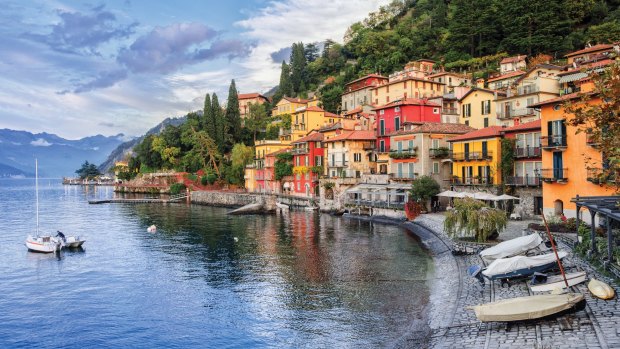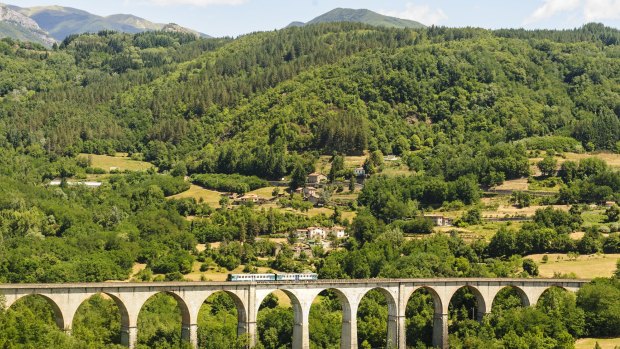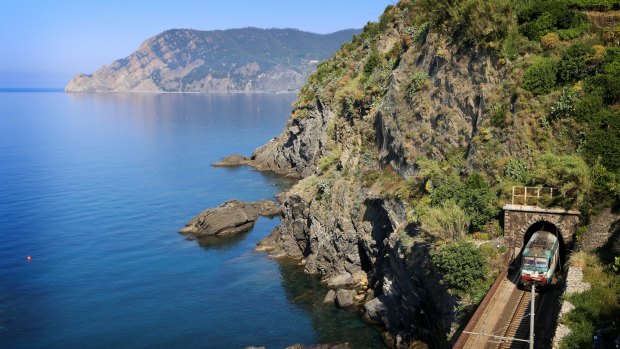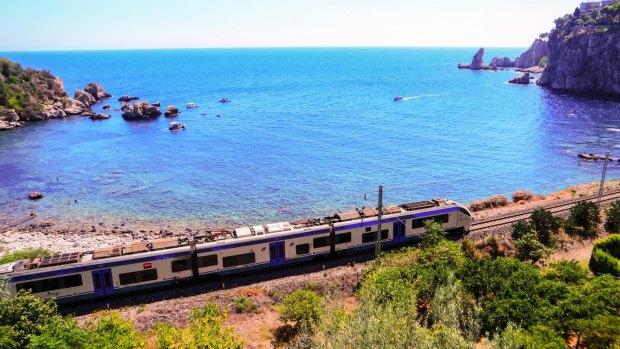This was published 5 years ago
Travelling Italy by public transport: How to travel Italy by bus and train without going insane

Menaggio on Lake Como.Credit: Shutterstock
It's been three hours since we missed our bus by waiting at the only bus shelter in Bagno Vignoni, which is not where you should wait for 54A. We're in the right place now standing, unsheltered, half a kilometre downhill from the village beside a main road flanked by bushland and paddocks.
Tuscan treetops, dramatically stage-lit by afternoon sun against the slate grey sky, radiate false hope that a second 54A will materialise and carry us closer to Radicofani where we're expected tonight. A cool wind sweeps the hot day aside and, as it starts to pelt down, a bus that isn't ours swings around the bend into view and my mother mutters "blow this" as she steps forward to flag it down.
The two of us are a few days into a month-long trip through Italy travelling as far north as the Swiss border and as far south as the coastal city of Otranto, where heel meets sole. Preparations were simple: we picked some places, plotted a rough route between all 15, booked accommodation and ordered Eurail passes. Italy isn't entirely new to either of us, Mum has learnt to speak the language fluently and I love a navigational challenge so the finer details of transport are being worked out now, on the ground.

Garfagnana in Lucca, Tuscany. Credit: Shutterstock
Immersion in the everyday life of a place is more important to both of us than making it to all the museums and cathedrals so we never contemplated separating ourselves from Italy while in Italy within the confines of a hire car. Though we have spent an inordinate amount of time, during these first few days, waiting for transport. But that's not Italy's fault.
Most places around the globe now use the same types of vehicles – buses, trains, ferries – for public transportation. Yet each country's system functions according to the culture, economy, population, climate. As soon as Mum and I remind ourselves we're in Italy and stop making assumptions about what a bus stop looks like and how often transport should run and start double-checking everything with locals we immediately get better at getting around.
Tuscany has been a good place to start because there's no more than 30 kilometres to travel between each place we're staying so it's a low-risk game we've created for ourselves. From Bagno Vignoni to Radicofani it's only 24 kilometres so we could conceivably walk that or hitch or work out how to get a taxi. The stakes are higher later in the trip when we're committed to covering more than 600 kilometres in a day from the commune of Casperia, near Rome, to Lecce in Puglia and, similarly, from the Umbrian city of Spoleto up to Lake Como.

The rugged Italian Riviera coastline, Cinque Terre, Italy. Credit: Shutterstock
Day-by-day problem solving on the road makes us feel alive and, not long into the trip, Mum vows to permanently revert to this independent-style travel she raised us on. Though she also wakes in the night in a cold sweat in the cave dark of an ancient trullo in Locorotondo wondering how the hell we're going to make our Matera connections. Her fears aren't unfounded – it's the greatest logistical challenge of the trip – but when we're triumphant she swears off the organised tours again.
Travelling in Italy is like learning English: there are rules but many exceptions. A fresh-ish paper timetable showing your particular route posted at a bus shelter generally means you're in the right place. Buses don't typically run on Sundays and sometimes not on Saturdays either, and regional trains can be likewise. During the week some villages are only serviced by one bus a day.
Regional train connections can occasionally change at the last minute. A conductor might pass through your carriage checking if anyone plans to alight at an upcoming station – determining if the train needs to stop there. A regional train may be suddenly cancelled then times for two replacement trains might appear on the station screens but, in the end, only one train leaves for that destination and earlier than indicated.

Train travel through Taormina in Sicily.Credit: Shutterstock
We learn the hard way to reserve long-distance train seats a few days – as opposed to a day or two – in advance. This can be done at any large station such as Milan, Rome, Bari, Lecce. Seat reservations for non-regional trains are compulsory and, on top of your Eurail Pass, cost about €10 per person per booking. Regional trains are inexpensive and don't require a reservation. On some routes in the south of Italy companies other than Trenitalia operating long-distance trains don't recognise our passes. So, before picking a Eurail Pass, research your planned route to make an economical choice.
Trenitalia's clean comfortable high-speed trains between major cites run so smoothly the coffee cart can glide through First Class as you hit 300km/h. Regional trains tend to be older and grungier. These may or may not have toilets and the pubic conveniences at smaller stations are rarely open. Good reasons to only drink espresso.
Italy to me is the charismatic friend whose company is truly stimulating, always looks amazing and brings the most fabulous food to a party but they're often running late, have dramas on the way and sometimes don't turn up at all. Yet I choose to spend time with them because everything else makes up for any exasperating qualities. Friends in Casperia say they know a lot of Germans who've moved to Italy "for the chaos".

Tuscany at sunrise.Credit: Shutterstock
Though in countries where public transport gives the impression of being unreliable it's my experience that, when it really matters, things run like clockwork. We have to leave Casperia by bus in the pre-dawn darkness to meet a regional train that will get us to Rome in time for the 8:05am to Lecce (the only long-distance train we could get seats on at short notice). That all-important bus, full of commuters also needing to catch the connection to Rome, collects us from Casperia exactly on time.
It's also in these less rule-driven places that strangers more often go further out of their way to help; perhaps because the boundaries – at least certain boundaries – aren't rigid. An Airbnb host in Milan minds my suitcase for the whole month for nothing. Someone in Monteroni walks out of their office and all the way to the end of the street to show us where to get transport to San Quirico d'Orcia. And that bus that wasn't ours did stop in a storm for my mother outside Bagno Vignoni.
She explained our situation and the driver invited us on board but refused to sell us tickets. While steering singlehandedly through the downpour he made a quick call and eventually pulled up at a service station – also not one of his designated stops – alongside a minibus with only a driver inside. That person also wouldn't take our money and delivered us right up to the old city walls of Radicofani. Where, over dinner that evening, a local I'd met the previous year nearly cried that we hadn't just called him for a lift.
TRIP NOTES
FLY
Most major airlines operate frequent flights from Sydney and Melbourne to Milan. See qantas.com; emirates.com
RIDE
Rail Europe offers single and multi-country Eurail Select Passes. Prices start at $229 for an Italy Pass. Multiple country passes start at $231 for two countries, $265 for three countries and $301 for four countries. For bookings and more information, see raileurope.com.au
Elspeth Callender travelled at her own expense and by train courtesy of Rail Europe.
HOW TO PLAY IT SAFE ON PUBLIC TRANSPORT IN ITALY
BE SMART
Being streetwise is the art of projecting your genuine trust in the people around you while being acutely aware a small percentage are seriously considering stealing your stuff.
PLAY THE GAME
Rather than quick-dry outdoor clothing and hiking boots consider taking it up a notch or 10 to blend in. Alternatively, go for dodgy-casual to confuse pickpockets into thinking you're in their line of work.
TRAVEL LIGHT
If you can get around with most of your gear in a small wheelie or duffel bag then you can dedicate more energy and attention to your surroundings.
ACCESSO-WISE
Keep anything you can't afford to lose in a crossbody bag – some come with slash resistant straps and compartments – that can be nonchalantly slid around to the front of your body when you feel the need.
GET INVENTIVE
Along with spooning all valuables when sleeping on an overnight train, hang a small bell on your compartment door. If you wake to find a shady figure silhouetted in the doorway then hissing "vai via" (go away) has been proven to work.
Sign up for the Traveller Deals newsletter
Get exclusive travel deals delivered straight to your inbox. Sign up now.